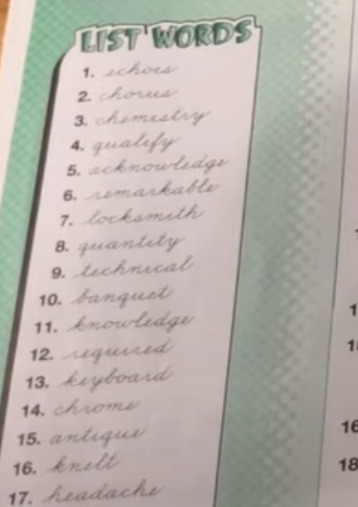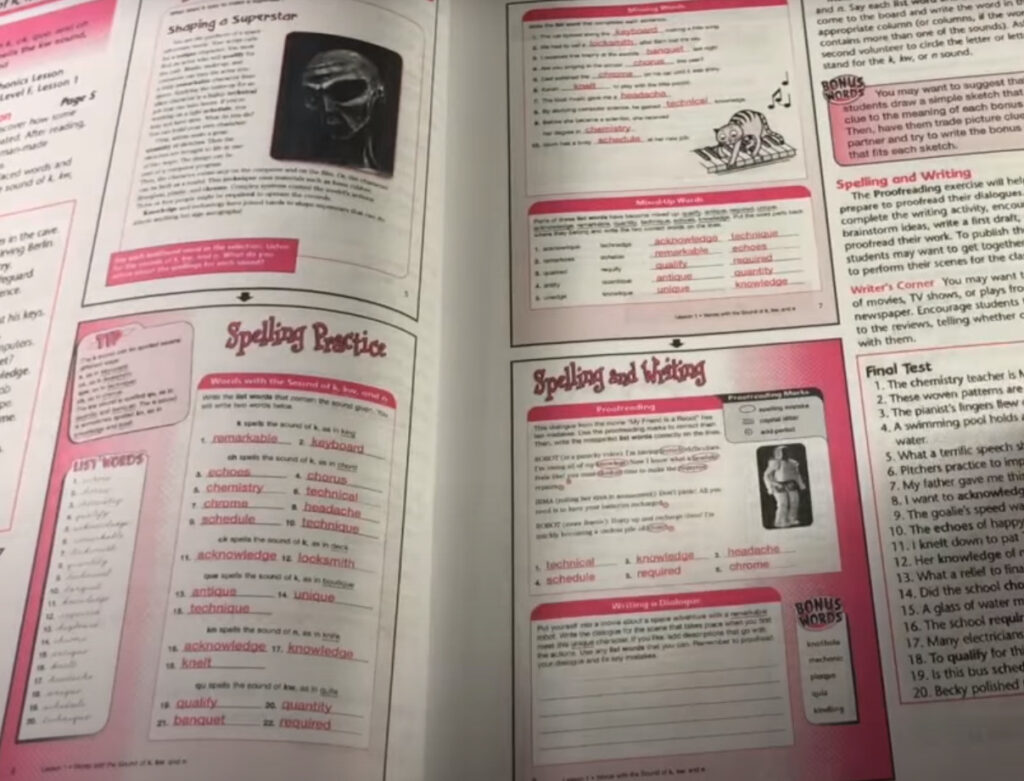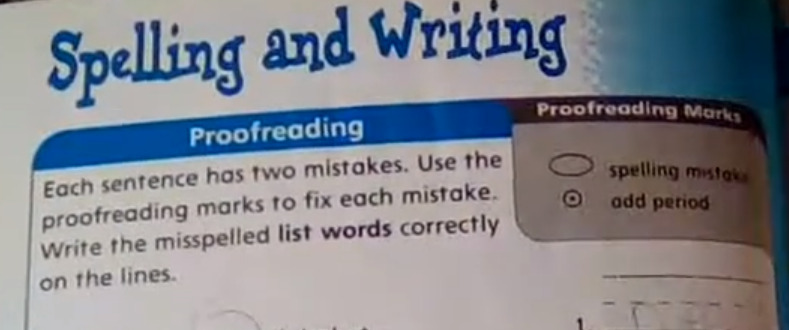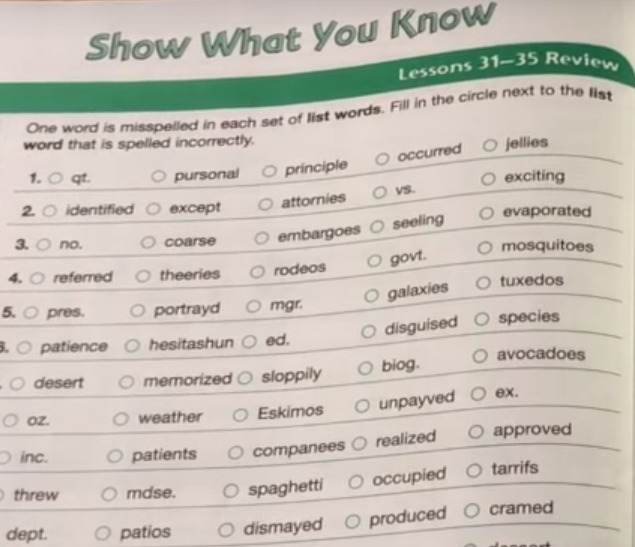
[W]ith its intuitive workbooks, short lessons, practice-based learning, low-pressure review and its wide variety of fun and even interesting activities, Spelling Workout might just be a way to help students hone their spelling skills (and beyond) without a lot of tears and frustration.
What We Like
But watch out for…
What is Spelling Workout
Originally created by Modern Curriculum Press, Spelling Workout is a spelling program aimed at, and used by, traditional schools and homeschooling families.
Across its series of 8 books, Spelling Workout teaches students to spell using a combination of different reading, spelling activities and writing exercises.
In addition to spelling, the program is notable for helping students practice a variety of different Language Arts skills, including reading, writing, dictionary skills, general vocabulary development, editing, proofreading and more.
What Ages or Grades is Spelling Workout Intended For?
Spelling Workout is designed for students in Grades 1-8, with each of its eight books and levels roughly corresponding to a particular grade.
| Level | Approximate Grade |
| A | 1 |
| B | 2 |
| C | 3 |
| D | 4 |
| E | 5 |
| F | 6 |
| G | 7 |
| H | 8 |
Although Spelling Workout’s books roughly correlate with specific grades, it can be fairly easily used by homeschooling students studying outside of a traditional grade progression, such as by students ahead or behind in their language development, so long as their reading ability is at the level of the intended grade range.
This flexibility of use is helped out by the fact that the program’s lessons are pretty short and the work is fairly intuitive at all levels, so there shouldn’t be much of an issue for more precocious students.
Similarly, as the books are alphabetically titled (A, B, C, D and so on), they can be a lot less stressful for students who are a little behind in their spelling, as there are no obvious grade designations on their covers that might embarrass or discourage them.
With all that said, homeschooling parents shifting into Spelling Workout from another program should note that there is no placement test available for the series.
Consequently, parents of students who are outside a typical grade progression will have to do a little homework to determine which level is best to start with.
While Spelling Workout broadly follows Pearson’s Plaid Phonics’ scope and sequence, which can serve as a good general guideline, to get the most accurate placement parents will have to examine each book’s table of contents and compare the study material to their child’s current spelling ability.
What’s Needed to Teach The Program?
Spelling Workout is a workbook-based spelling program, so it’s pretty lightweight as far as language arts curricula go.
In other words, the series doesn’t include a lot of moving parts or components to purchase and keep track of – for the most part Spelling Workout only really makes use of a student workbook and teacher’s edition.
Student workbook
The core of Spelling Workbook is really its student workbook.
This is where the student does most of their work and contains the program’s reading, word lists and various exercises and resources, all while providing ample room for responses.
The student workbooks are softcover, printed in two-tone color and are consumable.
Although they are fairly comprehensive and compact as far as workbooks go, they aren’t the most interesting to look at for students. They are illustrated, however, with various pictures and graphics to help break up the text and exercises a little bit.
For the most part the workbooks use standard print letters for both their instructions and as part of their word lists.
However, beginning at Level C (Grade 3), the word lists begin to include cursive as well, and the program eventually transitions to all cursive wordlists (the rest of the text remains print), which can be helpful for more traditional homeschools and those looking to include more cursive reading and writing practice in their studies, although perhaps something of an issue for homeschools that choose not to include cursive instruction.

Teachers’ edition
The Spelling Workout Teacher’s editions (which are sold separately) contain everything a parent might need to oversee and guide to teach a given level.
Like the workbooks, they are softcovers and are printed in two-tone color.
The books contain solutions to student work in the form of small reproductions of filled-in workbook pages, which is useful for grading.

They also contain 3 and 5-day lesson plan suggestions, instructions for each workbook activity, explanations for activities (including their logic and intended goals), pre- and post-lesson tests, tips and troubleshooting and even suggestions for extra activities that can help students better understand the material.
Because most of the program’s work is done in the student’s workbook, which is (to MCP’s credit) very intuitive and easy to use, some parents may be tempted to forgo purchasing the teacher’s edition completely.
Although this can be done, we believe that the teacher’s edition of Spelling Workout actually compliments the workbook learning quite well and can provide more of a comprehensive learning experience for students.
The teacher’s guides tend to place more of an emphasis on spelling rules than the workbooks alone (helpfully explaining them for parents, as well), and provide some extra activities that can help reinforce spelling skill, such as warmup and post-lesson dictation exercises, optional games and activity ideas and so on.
More than that, they provide a fair amount of detail concerning the reasoning and logic behind many of the activities, which in turn can help parents better understand what they’re doing and where/why their student might be struggling.
On the downside, however, parents should know that the teacher’s editions are pretty obviously written for traditional schooling, with explanations and activities referring to and designed for multiple students in a classroom setting.
Although this doesn’t really impact the overall usefulness of the program in any way, some homeschooling parents may be slightly annoyed by it at times.
Spelling Workout’s Approach to Spelling
Test-Study Method
Lessons in Spelling Workout follow what is called a Test-Study method. In other words, students begin their lessons with an assessment of their pre-existing knowledge before receiving new instruction.
More specifically, at the beginning of each lesson students are given a pre-test where they are given a list of words they haven’t been introduced to yet and do their best to spell them correctly, correcting their own mistakes and re-writing any misspellings.
The idea behind this method is that by testing a student’s knowledge before the actual lesson begins parents can get a better idea of where a student already stands in terms of their existing spelling ability, which in turn can help parents focus more on where a student needs help.
If a student gets a decent score on the pre-test, it’s a good indicator that they can probably skip the lesson and move to a topic they are less familiar with.
Spelling Workout’s particular pretest style, where students correct their own work, stands out a little bit from others as it can also help students learn to better analyze and correct their own writing and mistakes, and provides them with an opportunity to start discovering spelling patterns themselves before the lesson even begins, which is kind of cool.
As a downside, a test-study method can be less than ideal for students who develop anxiety around (or simply just don’t like) tests, as each lesson over the period of a year will begin with a short quiz that assesses them on things they actually haven’t learned yet
Workbook Learning
Spelling Workout teaches spelling largely through a combination of readings, various activities, writing exercises, dictation and, of course, word lists.
This gives students a lot of thorough practice in spelling, all of which is done from the convenience of a single, consumable workbook, so there’s not a whole lot for parents to buy or keep track of.
Similarly, there really isn’t a lot of memorization and repetitive review in this program as there is in other programs.
It is instead largely practice-based, which is good news for students who hate drill.
On the downside, the emphasis on workbook-based practice means that Spelling Workout doesn’t offer as much explicit, teacher-led instruction, particularly of spelling rules, as might be found in some other programs, such as All About Spelling or even Logic of English.
Additionally, revolving mostly around reading and writing, there aren’t a lot of hands-on or multisensory activities included in the lessons, so it may not appeal as much to more tactile or audio/visual students.
The teacher’s edition does offer a variety of ideas for more multisensory activities that parents can integrate into a lesson but, being written for teachers, largely leaves their execution and specifics up to the user, which may not be ideal for novice homeschoolers.
Phonics-based Approach to Spelling
Spelling Workout is a phonics-based spelling program.
Initially, students learn to spell using phonics, identifying letter sounds and combinations when spelling and doing lots of exercises involving word-sound relationships, and in later levels they begin to explore word origins and construction.
Lessons also introduce various spellings rules and phonics concepts, usually presented in their own box on certain pages, and as a result we feel Spelling Workout can be an effective compliment to just about any phonics-based reading program.
Not Just Word Lists
Lessons in Spelling Workout can include a fairly diverse range of activities.
Much like programs such as Wordly Wise 3000, Spelling Workout goes far beyond the simple memorization of word lists, offering students the opportunity to practice and hone their spelling skills through:
- Puzzles, such as crosswords and riddles
- Word analysis
- Proofreading and editing exercises
- Dictation exercises
- Various directed writing exercises
- And more
The wider range of activities throughout each book helps keep learning fresh, preventing students from getting too bored or simply going on autopilot as they fill out a workbook.
By and large, the activities are usually pretty straightforward, fairly intuitive and come with clear and simple instructions, so much of the work can be done by students on their own.

This means that students can engage in more independent learning, which is always a good skill to develop, and it means that the program is far less demanding of a parent’s time, which is good news for busier homeschools.
Parents should be aware, however, that these activities can often include a fair bit of reading, writing and comprehension, which can be a little challenging for students with dyslexia and processing disorders, as well as those with reading difficulties.
More Than Just Spelling
Finally, lessons and activities in Spelling Workout don’t only focus on spelling.
Quite often they allow students to work on a variety of different and important Language Arts skills, such as:
- Phonics and reading
- Reading comprehension
- Writing
- Reading cursive
- Proofreading and self-editing
- Dictionary skills
- Vocabulary development
As a result, Spelling Workout can be said to have a far more of a holistic, cross-curricular view of spelling and language than many other programs, letting students see spelling as part of a wider context and allowing them to hone multiple Language Arts skills as they practice their spelling.
That said, it does mean that a significant deficit in one area (reading comprehension, cursive or writing) can make it harder for a student to successfully complete their activities.
How It Works
By and large, Spelling Workout is pretty straightforward and intuitive as far as spelling programs go.
As we mentioned earlier, there are 8 books in the series (levels A-H), each of which roughly corresponds to a grade level (1-8).
Every level in the series is made up of about 36 lessons, with the idea that parents and teachers can spread a full lesson (about 4 pages in the workbook) out over the course of a week, making it a lot less intimidating and potentially overwhelming for students.
Lesson Structure
Typically, each lesson in Spelling Workout focuses on a particular phonic concept, spelling rule or pattern, and they tend to follow a very particular format of pretest, narrative exercise, activity-based practice, and a final test (at the teacher’s discretion).
This consistency of format can actually be quite beneficial, allowing students to feel more comfortable over time (as they know what to expect every lesson) and making it a lot easier for parents to plan and manage their student’s learning schedule.
Pretest
Before each lesson begins, parents are encouraged to offer a pretest where students are given words to try and spell that have not yet been introduced to them.
They then analyze their own work, correcting and rewriting any mistakes they may have made.
As mentioned previously, this can give parents a clearer idea of what a student knows and gives students an opportunity to hone their own self-editing skills and encourages them to find common patterns in spelling themselves, before a lesson officially begins.
Narrative
Lessons usually then begin with a text that students are expected to read, which serves to introduce the spelling words for the lesson in context and adds a bit of reading practice, which is always nice.
The texts themselves are usually pretty short, fitting on a single page, and are written at an appropriate grade level, so they shouldn’t be too challenging (or too easy) for most students.
They can also be kind of interesting, frequently touching on topics that students may actually want to read about, which is a nice change of pace from most programs.

Parents should note, however, that these narrative exercises are mainly found in the lower levels of the series (below level F, or Grade 6), i.e. at the grades in which students are typically still developing as readers.
Levels F and above simply jump right into the activities.
Activities
Following the narrative (if there is one), students begin the activity portion of their lesson.
After introducing the week’s word list, the lesson’s first activity usually involves working with a common spelling rule or phonic concept from that list.
Students may, for example, be asked to sort words from the list by a common feature, such as a phonic sound, prefix or ending.

In more advanced grades, they may have to sort them by meaning or by word origin, which can be an interesting and even thought-provoking challenge.
After this initial exercise, which is found in most lessons, the activities tend to change up significantly between lessons.
Students may, for example, be asked to fill in the blanks, unscramble words, define certain words, do some dictionary exercises, divide words up into their component syllables, and so on.
Typically, there is also a puzzle activity, such as a crossword or some kind of riddle, which can be fun for some students.
On the last page of a lesson, there is usually proofreading and writing exercises.
The proofreading exercises ask students to highlight and correct certain misspelled words and sentences, which is quite an interesting activity as it teaches students how to use common proofreading conventions and helps them develop a more critical eye for writing and spelling.

The written exercises are pretty straightforward – students are given a prompt and compose a short written piece.

On the whole, they can be a lot of fun and quite useful in the broader scheme of language arts practice, as there is a great deal of variety of writing that students can practice and many of the prompts correlate with what a student might be learning elsewhere in their language arts studies.
For example, students may write a letter, an ad, create content for a web page or even, at the highest levels, even write a short persuasive paragraph.
Following the proofreading and writing exercises, each lesson also offers an additional list of related, but more complex, words that parents and students can work on as enrichment.
Finally, at the end of each lesson, parents can use the teacher’s edition to give students a final summary dictation exercise.
Review
Every few lessons (about every 4 or so), Spelling Workout includes a full review lesson.
This review tests the learning included in those lessons by picking a selection of words from their individual word lists and giving students one of any number of activities to test their knowledge, such as crosswords or fill in the blanks.

The inclusion of a dedicated summary review can be very helpful, giving students a periodic opportunity to reinforce their learning and get extra practice while giving parents the chance to discover any knowledge or skill gaps t, and thus the opportunity to help correct them with focused practice before moving on.
At the end of each review, students are given a final exercise, called Show What You Know, where they have to find and circle misspelled words from a large list which, again, can be quite useful in helping students develop a more critical eye for spelling and editing.

We actually liked Spelling Workout’s review style quite a bit.
Compared to most other spelling reviews or summary assessments, which usually involve a memorization-based test of some kind, we feel that this activity-based review can be a lot less stress-inducing for students, particularly given the fact that the included activities are similar in style to those found in lessons, increasing the feeling of familiarity and comfort in students.
How Easy Is It To Teach?
Spelling Workout is a workbook-based spelling program that is very easy to teach.
The workbooks and their activities are quite intuitive, the instructions are quite clear and students should largely be able to do much of the work themselves without needing a lot of parental involvement beyond the administration of warm ups, pretests and final tests and, of course, overseeing the learning.
Similarly, Spelling Workout lessons are pretty short, usually only requiring an activity or two a day, which means they’re not as stressful or frustrating for students (or their parents) to go through.
The accompanying teacher’s edition makes things even easier.
Although clearly written for a school setting, we feel they really add a lot of lesson scripting and guidance and really do a good job at explaining each concept, activity and relevant spelling rules.
From time to time, they also offer helpful teaching tips and troubleshooting suggestions, as well as periodically offering ideas on how to better reinforce learning.
Ultimately, we feel that even parents who are new to homeschooling or have little confidence in their own spelling abilities should have little issue with this program.
Because it is so easy for students to go through on their own, we feel parents should, however, keep an eye on things to make sure that students are actively learning and paying attention to the spelling rules presented on each page and not simply going through the program on autopilot.
Pros and Cons of Spelling Workout
Pros
Affordable
With student workbooks costing less than $20, and a complete bundle with the teacher’s edition costing less than $30, Spelling Workout is a fairly affordable spelling program that should be able to fit most budgets.
Easy to Use
Spelling Workout doesn’t have a lot of components or moving parts to its teaching and is very lightweight and easy to use. Students do most of their learning and review by following the instructions in their workbook and parents can provide guidance and extra instruction by using a teacher’s manual.
Good variety of activities
Each lesson in Spelling Workout involves several different activities, and there are a variety of activities that can appear in any given lesson.
From crosswords to fill in the blanks to word jumbles, Spelling Workout temds to keep things interesting and can keep students on their toes as they learn.
Not very demanding of parents’ time
Thanks to its intuitive activities and clear instructions, most students should be able to do most of their activities themselves without a lot of parental involvement, freeing parents to focus on the many other tasks that homeschooling might involve.
Short Lessons
Lessons aren’t all that long in Spelling Workout, being only about 4 pages long, and are usually completed over the course of a week. On any given day, students might only need to complete a couple short spelling activities to stay on track, so the program isn’t very overwhelming or frustrating to learn from or teach.
Reinforces other Language Arts skills
Beyond spelling, Spelling Workout’s activities touch on a myriad of other Language Arts skills, such as writing, proofing, phonics, reading, reading comprehension, writing and more.
As such, it can help reinforce the skills being developed by other curricula, making it a versatile and natural homeschool ELA supplement.
Cons
Not as much explicit instruction as some other programs
While it does cover essential spelling rules, Spelling Workout doesn’t offer quite as much direct and explicit teaching and drill in these areas compared to other programs, which some students can benefit from.
Can be a little intense in terms of reading and writing
Some of the activities in Spelling Workout can involve reading, reading comprehension and writing, which can be an issue for students who struggle with these skills.
Who is Spelling Workout Ideal For?
Parents looking for a more independent learning spelling program
By and large, students can do much of Spelling Workout’s lesson activities on their own and with minimum parental intervention.
Not only does this promote independent learning skills, but parents can also step back into a more supervisory/guidance role and away from a direct instruction role, which will free them up to concentrate on other tasks.
Students who get bored with memorization and drill
Spelling Workout is a practice-based program that favors the use of written activities over rote memorization and repetition of spelling rules, word lists and concepts, and so likely won’t stress students who hate drill out so much.
Parents looking for a lightweight spelling program
Spelling Workout doesn’t involve a lot of material that parents will have to buy and keep track of. The program only really requires a consumable student workbook and a teacher’s edition.
Parents who want to integrate and practice other Language Arts skills at the same time
In addition to spelling, the diverse activities included in a Spelling Workout book allow students to work on their phonics, reading, writing, comprehension, proofreading and even dictionary skills, making it a very cross-curricular spelling program.
Students who get overwhelmed or frustrated with very long spelling lessons
Daily lessons in Spelling Workout are pretty short, usually only comprising a couple activities or exercises. As such, the learning is never that long or particularly frustrating for students to go through.
Homeschools on a budget
As it is a very affordable spelling program, with an entire year’s learning often costing less than $30, Spelling Workout is a good solution for homeschooling families who want a good quality spelling curriculum that can fit a tight budget.
Who is it Less Ideal For?
Students who get anxious when given assessments or tests
Spelling Workshop uses a Test-Study method of teaching, where each lesson begins with a pretest of concepts and words that students have not yet been taught (and typically end with a post-lesson test).
This method may frustrate or further stress out students who have test anxiety.
Students who really benefit from explicit instruction, memorization and drill of spelling rules
Although Spelling Workout does teach spelling rules, it does not do so quite as directly or explicitly as some other programs out there, which make the memorization and drill of these concepts a central part of their instructional style.
Students who prefer multisensory lessons
Spelling Workout is largely a workbook-based, reading-and-writing-heavy spelling program, and as such there really isn’t much in the way of hands-on or audiovisual learning involved, so students who favor these learning styles may not appreciate the program quite as much.
Price
Note: Prices correct as of writing. All prices in USD.
Each level of Spelling Workbook tends to include a student workbook and teacher’s manual/teacher’s edition, which make up a year’s learning in spelling.
Typically, these can be found for:
Student workbook: $13.50
Teacher’s edition: $15
Parents can often find the student workbook and teacher’s edition sold together as a bundle. Although it can depend on the retailer in question, these can typically be picked up for about $22.
As always it is important that parents check the current price, as well as a for any discounts or deals that may apply.
Or
Or
Is It Worth The Price?
With an entire year’s spelling instruction often costing less than $30, Spelling Workout is a pretty affordable spelling program.
Yet despite its low price we believe it can provide a lot of value for homeschooling families.
It is, for example, a lightweight and easy to use curriculum that doesn’t require parents to buy or keep track of a lot of manipulatives, flashcards, charts or other supplements throughout the year.
It also allows students to work fairly independently and isn’t very demanding of parents’ time, making it ideally suited for busy homeschools.
Further, the learning is phonics-based, meaning it is easy to integrate with phonics reading programs, and it is pretty thorough, with students practicing their spelling using a variety of fun, often uncommon and sometimes thought-provoking activities, including crosswords, proofreading exercises, writing prompts, jumbles and even dictionary look-ups.
The diversity of activities also means that Spelling Workout is fairly cross-curricular as a spelling program, providing students with the opportunity to sharpen many other Language Arts skills (reading, writing, comprehension) at the same time and allowing them to view spelling as part of the bigger picture of language.
Bottom Line
Working on spelling is far from every student’s favorite part of learning English.
But with its intuitive workbooks, short lessons, practice-based learning, low-pressure review and its wide variety of fun and even interesting activities, Spelling Workout might just be a way to help students hone their spelling skills (and beyond) without a lot of tears and frustration.

Jennifer Keenes is a writer and a new mom living in Florida. She studied education and, prior to becoming a freelance writer, worked as a substitute teacher at the elementary and middle school level. She is a big fan of the beach, working out and homeschooling her two daughters.
